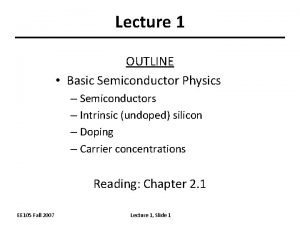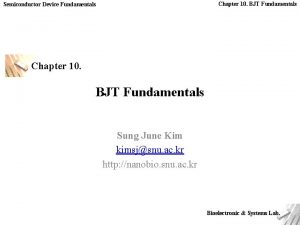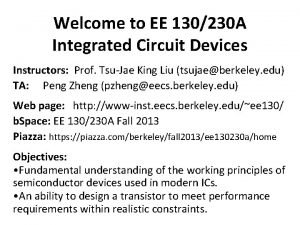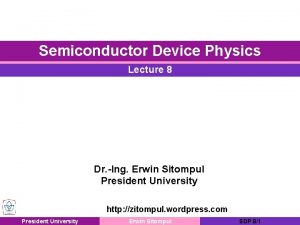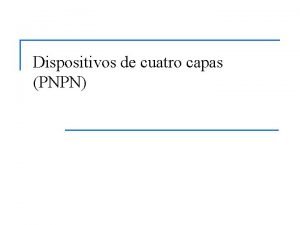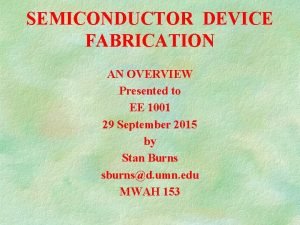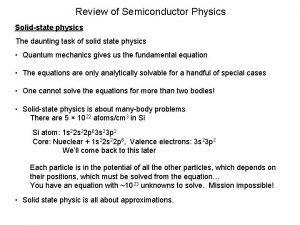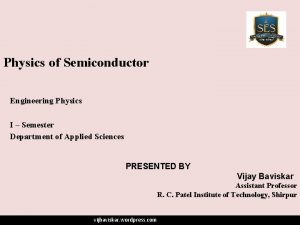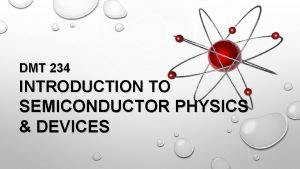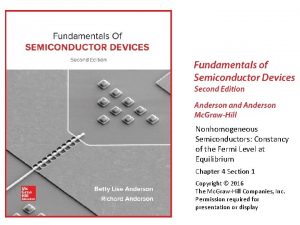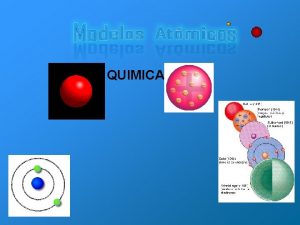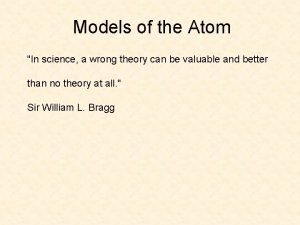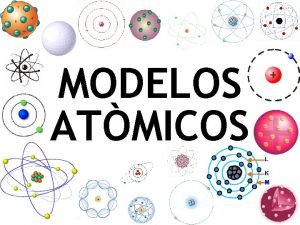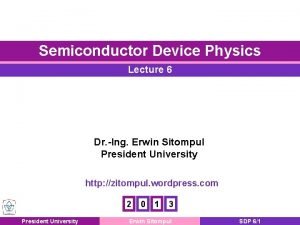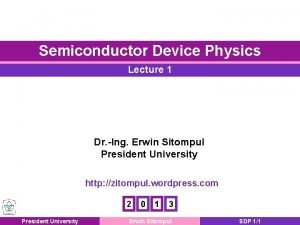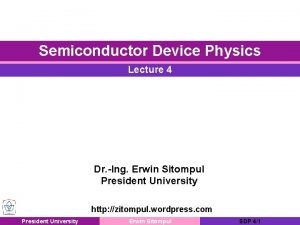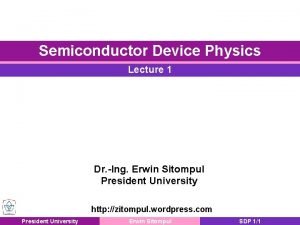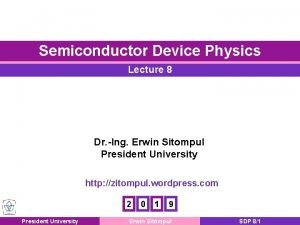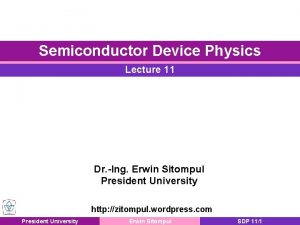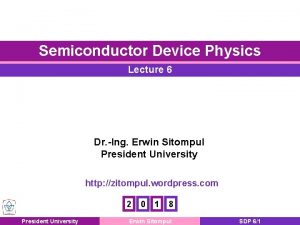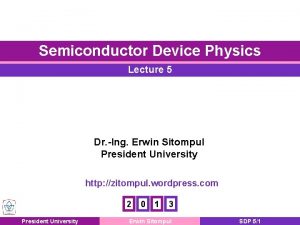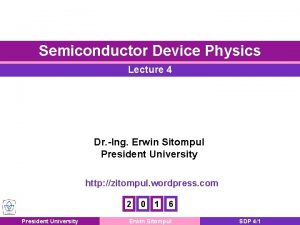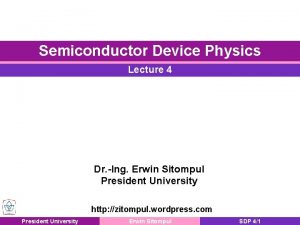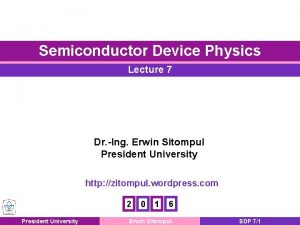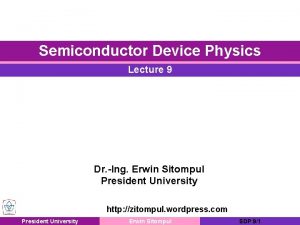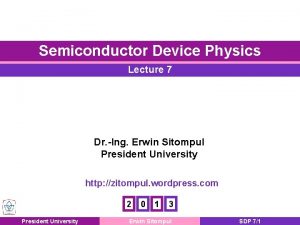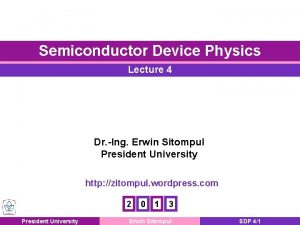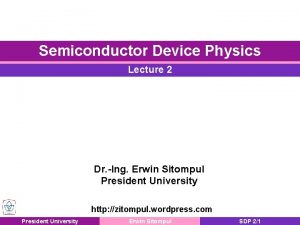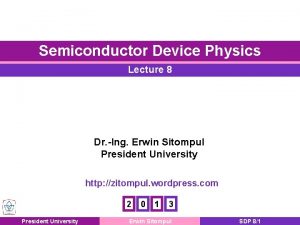Semiconductor Device Physics Lecture 5 Dr Ing Erwin























- Slides: 23

Semiconductor Device Physics Lecture 5 Dr. -Ing. Erwin Sitompul President University http: //zitompul. wordpress. com 2 President University 0 1 9 Erwin Sitompul SDP 5/1

Semiconductor Device Physics Chapter 5 pn Junction Electrostatics President University Erwin Sitompul SDP 5/2

Chapter 5 pn Junction Electrostatics Metallurgical Junction Doping profile Step junction idealization President University Erwin Sitompul SDP 5/3

Chapter 5 pn Junction Electrostatics Poisson’s Equation Poisson’s equation is a well-known relationship in electricity and magnetism. It is now used because it often contains the starting point in obtaining quantitative solutions for the electrostatic variables. In one-dimensional problems, Poisson’s equation simplifies to: President University Erwin Sitompul SDP 5/4

Chapter 5 pn Junction Electrostatics Equilibrium Energy Band Diagram pn-Junction diode President University Erwin Sitompul SDP 5/5

Chapter 5 pn Junction Electrostatics Qualitative Electrostatics Equilibrium condition Band diagram Electrostatic potential President University Erwin Sitompul SDP 5/6

Chapter 5 pn Junction Electrostatics Qualitative Electrostatics Equilibrium condition Electric field Charge density President University Erwin Sitompul SDP 5/7

Chapter 5 pn Junction Electrostatics Formation of pn Junction and Charge Distribution q. NA– President University Erwin Sitompul q. ND+ SDP 5/8

Chapter 5 pn Junction Electrostatics Formation of pn Junction and Charge Distribution President University Erwin Sitompul SDP 5/9

Chapter 5 pn Junction Electrostatics Built-In Potential Vbi • Vbi for several materials: Ge ≤ 0. 66 V Si ≤ 1. 12 V Ge. As ≤ 1. 42 V For non-degenerately doped material, President University Erwin Sitompul SDP 5/10

Chapter 5 pn Junction Electrostatics Relation between ρ(x), E(x), and V(x) 1. Find the profile of the built-in potential Vbi 2. Use the depletion approximation ρ(x) With depletion-layer widths xp, xn unknown 3. Integrate ρ(x) to find E(x) Boundary conditions E(–xp) = 0, E(xn)=0 4. Integrate E(x) to obtain V(x) Boundary conditions V(–xp) = 0, V(xn) = Vbi 5. For E(x) to be continuous at x = 0, NAxp = NDxn Solve for xp, xn President University Erwin Sitompul SDP 5/11

Chapter 5 pn Junction Electrostatics The Depletion Approximation On the p-side, ρ = –q. NA with boundary E(–xp) = 0 On the n-side, ρ = q. ND with boundary E(xn) = 0 President University Erwin Sitompul SDP 5/12

Chapter 5 pn Junction Electrostatics Step Junction with VA = 0 Solution for ρ Solution for E Solution for V President University Erwin Sitompul SDP 5/13

Chapter 5 pn Junction Electrostatics Step Junction with VA=0 At x = 0, expressions for p-side and n-side for the solutions of E and V must be equal: President University Erwin Sitompul SDP 5/14

Chapter 5 pn Junction Electrostatics Depletion Layer Width Eliminating xp, Eliminating xn, Summing Exact solution, try to derive President University Erwin Sitompul SDP 5/15

Chapter 5 pn Junction Electrostatics One-Sided Junctions If NA >> ND as in a p+n junction, If ND >> NA as in a n+p junction, Simplifying, where N denotes the lighter dopant density President University Erwin Sitompul SDP 5/16

Chapter 5 pn Junction Electrostatics Example: Depletion Layer Width A p+n junction has NA = 1020 cm– 3 and ND = 1017 cm– 3, at 300 K. a) What is. Vbi? b) What is W? c) What is xn? d) What is xp? President University Erwin Sitompul SDP 5/17

Chapter 5 pn Junction Electrostatics Step Junction with VA 0 • To ensure low-level injection conditions, reasonable current levels must be maintained VA should be small President University Erwin Sitompul SDP 5/18

Chapter 5 pn Junction Electrostatics Step Junction with VA 0 In the quasineutral, regions extending from the contacts to the edges of the depletion region, minority carrier diffusion equations can be applied since E ≈ 0. In the depletion region, the continuity equations are applied. President University Erwin Sitompul SDP 5/19

Chapter 5 pn Junction Electrostatics Step Junction with VA 0 Built-in potential Vbi (non-degenerate doping): Depletion width W : President University Erwin Sitompul SDP 5/20

Chapter 5 pn Junction Electrostatics Effect of Bias on Electrostatics • If voltage drop â, then depletion width â • If voltage drop á, then depletion width á President University Erwin Sitompul SDP 5/21

Chapter 5 pn Junction Electrostatics Linearly-Graded Junction President University Erwin Sitompul SDP 5/22

Chapter 5 pn Junction Electrostatics Homework 5 1. (6. 4) 2. (7. 6) Consider a silicon pn junction at T = 300 K with a p-side doping concentration of NA = 1018 cm– 3. Determine the n-side doping concentration such that the maximum electric field is |Emax| = 3× 105 V/cm at a reverse bias voltage of (i) VR = 25 V; (ii) VR = 5 V. Problem 5. 4 Pierret’s “Semiconductor Device Fundamentals”. Change ND from 1015 /cm 3 to 3× 1015 /cm 3. Deadline: Wednesday, 16 October 2019, at 10: 30. Next week class will be on Wednesday, 16 October 2019. No class on Friday, 18 October 2019. President University Erwin Sitompul SDP 5/23
 Cpu output device
Cpu output device Basic semiconductor physics:
Basic semiconductor physics: Power semiconductor devices lecture notes
Power semiconductor devices lecture notes Semiconductor device fundamentals
Semiconductor device fundamentals Semiconductor device fundamentals
Semiconductor device fundamentals Semiconductor device fundamentals
Semiconductor device fundamentals Diac de cuatro capas
Diac de cuatro capas Semiconductor device fabrication
Semiconductor device fabrication What is a semiconductor
What is a semiconductor Wigner seitz cell of fcc
Wigner seitz cell of fcc Semiconductor engineering physics
Semiconductor engineering physics Dmt 234
Dmt 234 Semiconductor types
Semiconductor types 01:640:244 lecture notes - lecture 15: plat, idah, farad
01:640:244 lecture notes - lecture 15: plat, idah, farad Physics 111 lecture notes
Physics 111 lecture notes Physics 101 lecture notes pdf
Physics 101 lecture notes pdf Phy101 lecture 1
Phy101 lecture 1 Physics 101 lecture notes pdf
Physics 101 lecture notes pdf What is wave motion
What is wave motion Atmospheric physics lecture notes
Atmospheric physics lecture notes Art as a humanistic discipline summary
Art as a humanistic discipline summary Modelo de dalton mg
Modelo de dalton mg Erwin schrödinger atomic theory
Erwin schrödinger atomic theory Modelo atomico de sommerfeld
Modelo atomico de sommerfeld

